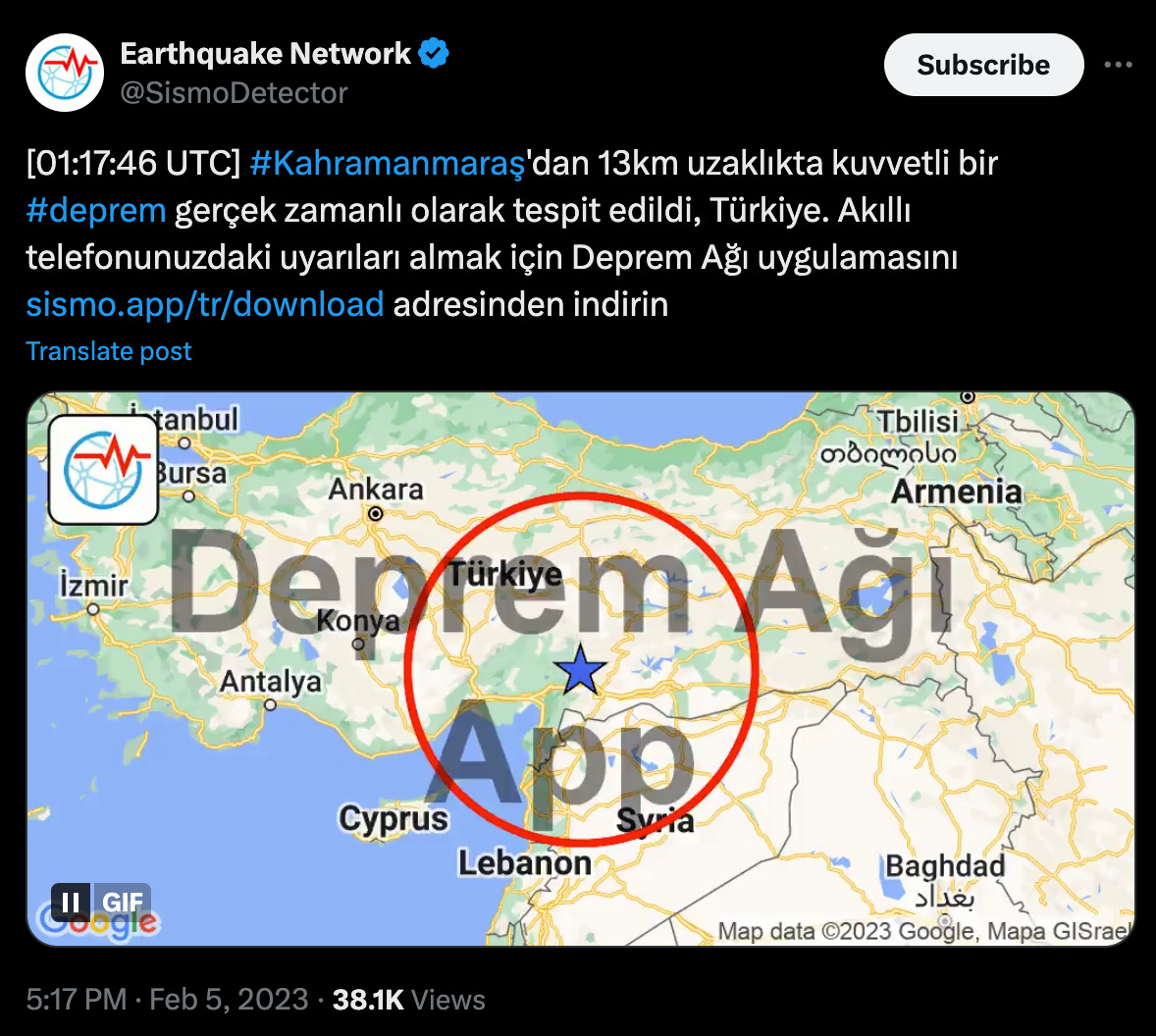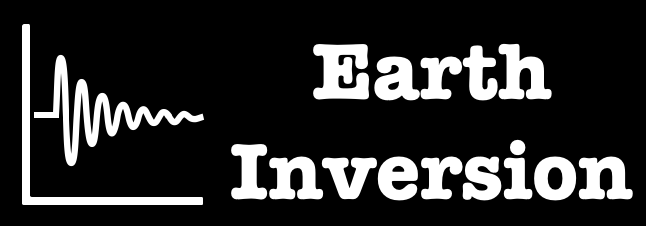Public Earthquake Early Warning Systems (PEEWS) have the potential to save lives by warning people of incoming seismic waves up to tens of seconds in advance. Given the scale and geographical extent of their impact, this potential is greatest for destructive earthquakes, such as the M7.8 Pazarcik (Türkiye) event of 6 February 2023, which killed almost 60,000 people. However, warning people of imminent strong shaking is particularly difficult for large-magnitude earthquakes because the warning must be given before the earthquake has reached its final size. This review discusses key findings and insights from the paper titled “Smartphones Enabled Up to 58 Seconds Strong-Shaking Warning in the M7.8 Türkiye Earthquake,” authored by Francesco Finazzi, Rémy Bossu, and Fabrice Cotton. The study focuses on the Earthquake Network (EQN), a public smartphone-based Earthquake Early Warning System (PEEWS), and its performance during the M7.8 Pazarcik earthquake in Türkiye on February 6, 2023.
Introduction to PEEWS and EQN
Public Earthquake Early Warning Systems (PEEWS) leverage seismic monitoring technologies and communication infrastructures to provide advance warnings of incoming seismic waves. Traditional PEEWS are limited by high implementation costs and legislative challenges. These systems involve installing and maintaining a network of seismic sensors, developing robust communication infrastructure, and ensuring the systems’ continuous operation and upgrades. Additionally, navigating complex regulatory and legal frameworks can complicate deployment and operation. Smartphone-based PEEWS, such as the EQN, offer a low-cost, crowdsourced alternative that utilizes smartphones to detect and alert users of earthquakes. Google’s Android Earthquake Alerts System, another global smartphone-based PEEWS, became operational in select countries from 2021.
Operation and Performance of EQN
The Earthquake Network (EQN) app plays a crucial role in providing real-time seismic monitoring through smartphones. The process begins with the installation of the EQN app on smartphones, which can be Android, iOS, or Huawei devices. Once installed, the app enables the smartphone to become a part of a crowdsourced seismic network.
Activation and Monitoring
The app’s seismic monitoring functionality is activated primarily when the smartphone is charging. This approach is designed to conserve battery life while ensuring continuous monitoring. When activated, the app utilizes the smartphone’s built-in accelerometer to monitor real-time acceleration data. The accelerometer is sensitive enough to detect significant ground shaking that could indicate an earthquake.
Data Collection and Transmission
Upon detecting significant shaking that exceeds a predefined threshold, the app performs several critical tasks:
- Calculation of Peak Acceleration: The app calculates the peak resultant acceleration over a three-second window. This measure, known as the smartphone peak resultant acceleration, captures the intensity of the detected shaking.
- Data Transmission: The calculated peak resultant acceleration, along with the smartphone’s GPS coordinates, is transmitted to the EQN server infrastructure. It is important to note that no waveforms are sent, minimizing data usage and ensuring privacy.
Server Analysis and Earthquake Estimation
Once the data reaches the EQN servers, a sophisticated analysis process begins:
- Median Acceleration Calculation: The server aggregates the data from multiple smartphones to calculate the EQN median acceleration. This median value provides a reliable estimate of the shaking intensity across a broader area.
- Magnitude Estimation: Using the median acceleration, the server infers the magnitude of the detected earthquake. This step is crucial for determining the potential impact of the seismic event.
- Warning Distance Determination: Based on the estimated magnitude, the server calculates warning distances for different levels of ground shaking – mild, moderate, and strong.
Personalized Alerts and Notifications
Once the server has determined the necessary information, personalized alerts are generated and sent to EQN app users. These alerts include:
- Countdown to S-Wave Arrival: Users receive a countdown timer indicating the expected arrival of the S-wave, which typically causes the most damage during an earthquake.
- Expected Ground-Shaking Intensity: The alert specifies the expected intensity of ground shaking at the user’s location, helping them take appropriate protective measures.
User Engagement and App Performance
The EQN app’s ability to provide timely and personalized alerts depends on the active participation of its users. By leveraging the collective data from a network of smartphones, the system can offer more accurate and localized warnings. The effectiveness of the app during events like the M7.8 Pazarcik earthquake demonstrates its potential to save lives by providing crucial seconds of warning before the onset of strong ground shaking.
This comprehensive approach ensures that the EQN system can deliver reliable earthquake detection and warning services, leveraging modern smartphone technology to enhance public safety in seismic-prone regions.
EQN’s Performance During the Pazarcik Earthquake
The Pazarcik earthquake was among the deadliest events in recent history, highlighting the critical role of effective PEEWS. At the time of this earthquake, Türkiye lacked a national PEEWS, but both EQN and Google’s system were operational. Notably, the EQN system successfully detected the earthquake within 12 seconds of the initial rupture, while Google’s system failed to alert users. EQN users received alerts with warning times of up to 58 seconds, allowing them to take protective actions.

Analysis of the EQN Alerting Strategy
The EQN’s alerting strategy is akin to the onsite approach, estimating alerting distances from the initial seismic waves without waiting for the earthquake to reach its full size. This strategy proved effective during the Pazarcik earthquake, with the EQN issuing alerts to 382 users within a 141 km radius for strong shaking, 738 users within a 412 km radius for moderate shaking, and 62,419 users within a 3506 km radius for mild shaking. The system’s reliance on Firebase Cloud Messaging enables it to alert up to 100,000 users per second.
Limitations and Challenges
Despite its success, the EQN system faced significant challenges during the Pazarcik earthquake:
- Infrastructure Saturation: Following the initial M7.8 event, the number of Turkish users increased dramatically from 33,000 to 225,000 within a few hours. This rapid surge in users overwhelmed the EQN server infrastructure, leading to a temporary service disruption. This saturation prevented the detection of the subsequent M7.5 Elbistan earthquake, which occurred nine hours after the initial quake. While this issue was resolved within two days by adding more servers, it highlights the need for scalable infrastructure to handle sudden increases in user numbers.
- Alert Distribution Speed: The EQN system relies on Firebase Cloud Messaging to send alerts, with a current rate of approximately 100,000 users per second. Although this rate is sufficient for normal operations, it may not be fast enough to alert millions of users in a densely populated area before seismic waves arrive. The system might need to adopt alternative alerting methods with higher distribution speeds.
- User Engagement and Sustainability: The EQN project is funded by users who purchase the PRO version of the app or its priority services, which guarantees them to be among the first 100,000 to receive alerts. This funding model might limit the system’s ability to provide equitable service during large-scale emergencies. Ensuring widespread and sustained user engagement remains a challenge, as the effectiveness of the system relies heavily on the participation of a large number of users.
Conclusion
The study demonstrates the EQN’s capability to provide timely earthquake warnings, potentially saving millions of lives. The analysis shows that approximately 2.7 million people exposed to life-threatening shaking could have received warnings with times ranging from 30 to 66 seconds. The effectiveness of the EQN during the Pazarcik earthquake underscores the importance of smartphone-based PEEWS, especially in regions lacking traditional early warning systems.
References
- Finazzi, F., Bossu, R., & Cotton, F. (2024). Smartphones enabled up to 58 s strong-shaking warning in the M7.8 Türkiye earthquake. Scientific Reports, 14, 4878. https://doi.org/10.1038/s41598-024-55279-z
- BBC Technology. (2023). Google’s earthquake alert system failed during Turkey quake. https://www.bbc.com/news/technology-66316462
- Twitter. (2023). SismoDetector status.

Greetings! I’ve been reading your site for a while now and finally got the
bravery to go ahead and give you a shout out from Austin Texas!
Just wanted to tell you keep up the great job!
Hello, its pleasant paragraph regarding media print, we all know media is
a wonderful source of data.
What’s up, just wanted to tell you, I loved this article.
It was helpful. Keep on posting!
Hi, this weekend is pleasant for me, because this time
i am reading this great informative piece of writing here at my home.
I constantly emailed this web site post page to all
my contacts, for the reason that if like to read it then my
links will too.
I really like your blog.. very nice colors & theme.
Did you design this website yourself or did you hire someone
to do it for you? Plz respond as I’m looking to create my
own blog and would like to find out where u got this from.
cheers
If some one wants to be updated with latest technologies therefore he must be pay a visit this web
page and be up to date all the time.
Hi there, I believe your site may be having web browser compatibility issues.
Whenever I look at your site in Safari, it looks fine however,
if opening in IE, it has some overlapping issues.
I merely wanted to provide you with a quick heads up!
Besides that, excellent site!
YVLTqsHjRjpvCvEME